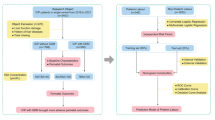Abstract
Purpose
Intrahepatic cholestasis of pregnancy (ICP) is a disease associated with high-perinatal morbidity and mortality rates. It is important to have parameters that aid in predicting fetal outcomes. Certain parameters affecting asphyxia in newborns to mothers with ICP are evaluated in this study.
Methods
One hundred eighty-seven cholestatic pregnancies were analyzed, retrospectively. Fetal asphyxia was defined as an APGAR score of less than 7 at 5 min postpartum. Predictors of asphyxia in ICP were analyzed by binary multivariate logistic regression analysis.
Results
Thirty-six of the cholestatic pregnancies ended up having an asphyctic newborn at the time of delivery (19.2%). There was a statistically significance difference in the levels of total bile acids (TBA) (42.4 ± 15.2 vs. 33.8 ± 12.9 μmol/L, P < 0.01), HDL cholesterol (54.2 ± 15.9 vs. 61.3 ± 12.2, P = 0.01), total cholesterol (279.0 ± 51.4 vs. 257.7 ± 51.6, P = 0.02), and triacylglycerol (299.4 ± 94.6 vs. 260.4 ± 118.7) between the asphytic and nonasphytic group. Binary multivariate logistic regression analysis demonstrated that TBA levels (OR 1.04, 95% CI 1.01–1.08, P = 0.03) and exposure time (OR 1.11, 95% CI 1.05–1.17, P < 0.01) were the most important independent variables predicting fetal asphyxia in ICP.
Conclusions
In this study, it has been demonstrated that for the evaluation of fetal status, increased TBA levels in the mother and increased exposure time for the fetus to these increased values of TBA within the maternal circulation system help to predict increased risk of asphyxia in newborns to ICP mothers.
Similar content being viewed by others
References
Lammert F, Marschall HU, Glantz A, Matern S (2000) Intrahepatic cholestasis of pregnancy: molecular pathogenesis, diagnosis and management. J Hepatol 33:1012–1021. doi:10.1016/S0168-8278(00)80139-7
Beuers U, Pusl T (2006) Intrahepatic cholestasis of pregnancy—a heterogeneous group of pregnancy-related disorders? Hepatology 43:647–649. doi:10.1002/hep.21156
Bacq Y, Sapey T, Brechot MC, Pierre F, Fignon A, Dubois F (1997) Intrahepatic cholestasis of pregnancy: a French prospective study. Hepatology 26:358–364. doi:10.1002/hep.510260216
Glantz A, Marschall HU, Mattsson L (2004) Intrahepatic cholestasis of pregnancy: relationship between bile acids levels and fetal complication rates. Hepatology 40:467–474. doi:10.1002/hep.20336
Howard PJ, Murphy GM (2003) Bile acid stress in the mother and baby unit. Eur J Gastroenterol Hepatol 15:317–321. doi:10.1097/00042737-200303000-00016
Sentilhes L, Verspyck E, Pia P et al (2006) Fetal death in a patient with intrahepatic cholestasis of pregnancy. Obstet Gynecol 107:458–460
Alsulyman OM, Ouzounian JG, Ames-Castro M et al (1996) Intrahepatic cholestasis of pregnancy: perinatal outcome associated with expectant management. Am J Obstet Gynecol 175:957–960. doi:10.1016/S0002-9378(96)80031-7
Zecca E, De Luca D, Barbato G, Marras M, Tiberi E, Romagnoli C (2007) Predicting respiratory distress syndrome in neonates from mothers with intrahepatic cholestasis of pregnancy. Early Hum Dev 84:337–341. doi:10.1016/j.earlhumdev.2007.09.012
Zecca E, De Luca D, Marras M, Caruso A, Bernardini T, Romagnoli C (2006) Intrahepatic cholestasis of pregnancy and neonatal respiratory distress syndrome. Pediatrics 117:1669–1672. doi:10.1542/peds.2005-1801
Rioseco AJ, Ivankovic MB, Manzur A, Hamed F, Kato SR, Parer JT, Germain AM (1994) Intrahepatic cholestasis of pregnancy: a retrospective case–control study of perinatal outcome. Am J Obstet Gynecol 170:890–895
Piazze J, Padula F, Cerekja A, Cosmi EV, Anceschi MM (2005) Prognostic value of umbilical-middle cerebral artery pulsatility index ratio in fetuses with growth restriction. Int J Gynaecol Obstet 91:233–237. doi:10.1016/j.ijgo.2005.08.015
Fagan EA (1999) Intrahepatic cholestasis of pregnancy. Clin Liver Dis 3:603–632. doi:10.1016/S1089-3261(05)70087-8
Germain AM, Carvajal JA, Glasinovic JC, Kato CS, Williamson C (2002) Intrahepatic cholestasis of pregnancy: an intriguing pregnancy-specific disorder. J Soc Gynecol Investig 9:10–14. doi:10.1016/S1071-5576(01)00144-7
Heinonen S, Kirkinen P (1999) Pregnancy outcome with intrahepatic cholestasis. Obstet Gynecol 94:189–193. doi:10.1016/S0029-7844(99)00254-9
Marin JJ, Macias RI, Serrano MA (2003) The hepatobiliary-like excretory function of the placenta. A review. Placenta 24:431–438. doi:10.1053/plac.2002.0951
Meng LJ, Reyes H, Palma J, Hernandez J, Ribalta J, Sjovall J (1996) Progesterone metabolism in normal human pregnancy and in patients with intrahepatic cholestasis of pregnancy. In: Reyes HB, Leuschner U, Arias IM (eds) Pregnancy sex hormones and the liver. Kluwer, Dordrecht, pp 91–100
Monte MJ, Rodriguez-Bravo T, Macias RI, Bravo P, el-Mir MY, Serrano MA, Lopez-Salva A, Marin JJ (1995) Relationship between bile acid transplacental gradients and transport across the fetal-facing plasma membrane of the human trophoblast. Pediatr Res 38:156–163. doi:10.1203/00006450-199508000-00004
Sepulveda WH, Gonzalez C, Cruz MA, Rudolph MI (1991) Vasoconstrictive effect of bile acids on isolated human placental chorionic veins. Eur J Obstet Gynecol Reprod Biol 42:211–215. doi:10.1016/0028-2243(91)90222-7
Castano G, Lucangioli S, Sookoian S, Mesquida M, Lemberg A, Di Scala M, Franchi P, Carducci C, Tripodi V (2006) Bile acid profiles by capillary electrophoresis in intrahepatic cholestasis of pregnancy. Clin Sci (Lond) 110:459–465. doi:10.1042/CS20050302
Glantz A, Marschall HU, Lammert F et al (2005) Intrahepatic cholestasis of pregnancy: a randomized controlled trial comparing dexamethasone and ursodeoxycholic acid. Hepatology 42:1399–1405. doi:10.1002/hep.20952
Kondrackiene J, Beuers U, Kupcinskas L (2005) Efficacy and safety of ursodeoxycholic acid versus cholestyramine in intrahepatic cholestasis of pregnancy. Gastroenterology 129:894–901. doi:10.1053/j.gastro.2005.06.019
Wojcicka J, Sienko J, Smolarczyk R, Romejko E, Grymowicz M, Czajkowski K (2005) Alpha-hydroxybutyrate dehydrogenase activity in intrahepatic cholestasis of pregnancy. Int J Gynaecol Obstet 89:247–250. doi:10.1016/j.ijgo.2005.02.015
Conflict of interest statement
None.
Author information
Authors and Affiliations
Corresponding author
Rights and permissions
About this article
Cite this article
Oztekin, D., Aydal, I., Oztekin, O. et al. Predicting fetal asphyxia in intrahepatic cholestasis of pregnancy. Arch Gynecol Obstet 280, 975–979 (2009). https://doi.org/10.1007/s00404-009-1052-x
Received:
Accepted:
Published:
Issue Date:
DOI: https://doi.org/10.1007/s00404-009-1052-x




